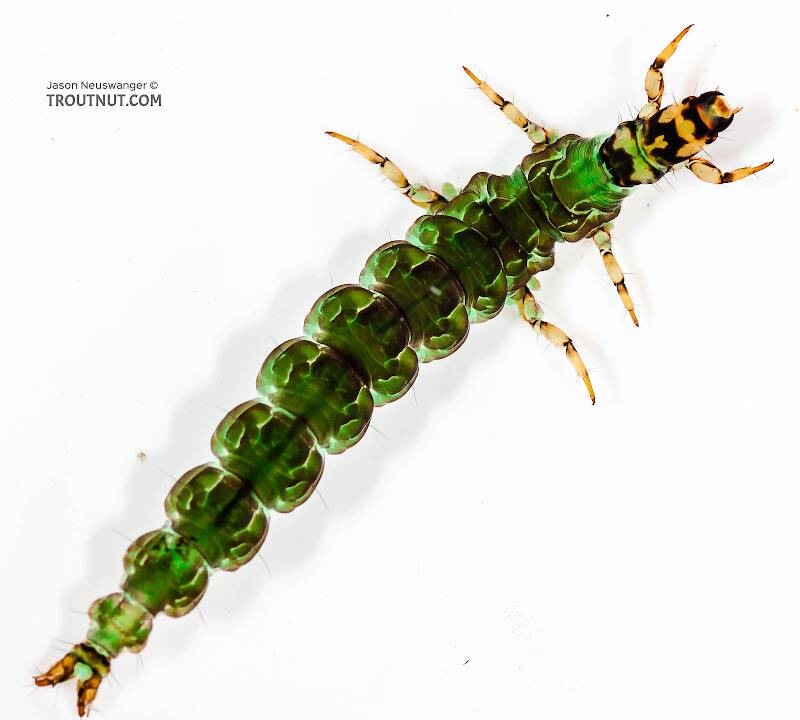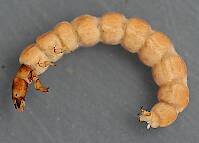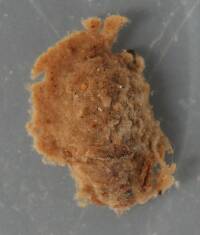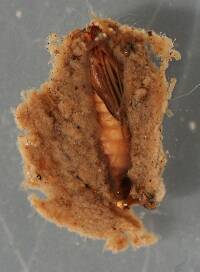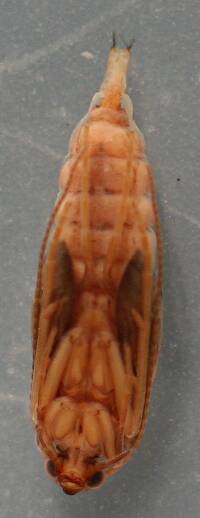
Hex Mayflies
Hexagenia limbata
The famous nocturnal Hex hatch of the Midwest (and a few other lucky locations) stirs to the surface mythically large brown trout that only touch streamers for the rest of the year.
Featured on the forum

Some characteristics from the microscope images for the tentative species id: The postero-lateral projections are found only on segment 9, not segment 8. Based on the key in Jacobus et al. (2014), it appears to key to Neoleptophlebia adoptiva or Neoleptophlebia heteronea, same as this specimen with pretty different abdominal markings. However, distinguishing between those calls for comparing the lengths of the second and third segment of the labial palp, and this one (like the other one) only seems to have two segments. So I'm stuck on them both. It's likely that the fact that they're immature nymphs stymies identification in some important way.

Troutnut is a project started in 2003 by salmonid ecologist Jason "Troutnut" Neuswanger to help anglers and
fly tyers unabashedly embrace the entomological side of the sport. Learn more about Troutnut or
support the project for an enhanced experience here.
LittleJ on Nov 4, 2008November 4th, 2008, 2:19 pm EST
any one know if we have these guys on spring creek(pa) ? I was putting together my box for fri. and realized all I know of spring creek caddis are tan and no grannoms.
thanks
Jeff
thanks
Jeff
Taxon on Nov 4, 2008November 4th, 2008, 5:36 pm EST
Jeff-
See this Spring Creek PA Hatch Chart:

The Green Caddis hatch listed on it would be Rhyacophilidae (Freeliving Caddis). All but one of the ~128 North American species are in genus Rhyacophila. Of those, ~17 Rhyacophila species are found in Pennsylvania. Perhaps someone familiar with Spring Creek can narrow those ~17 down to the species which are actually found in it. Hope this helps.
See this Spring Creek PA Hatch Chart:

The Green Caddis hatch listed on it would be Rhyacophilidae (Freeliving Caddis). All but one of the ~128 North American species are in genus Rhyacophila. Of those, ~17 Rhyacophila species are found in Pennsylvania. Perhaps someone familiar with Spring Creek can narrow those ~17 down to the species which are actually found in it. Hope this helps.
JAD on Nov 5, 2008November 5th, 2008, 2:24 am EST
Hello all
Jeff this is a great site on Pa, if you haven't seen it before try this one.---http://paaquaticfliesrus.bd.psu.edu/webroot/fly_picker.asp?fly_id=1
Hope this helps you
John---JaD
Jeff this is a great site on Pa, if you haven't seen it before try this one.---http://paaquaticfliesrus.bd.psu.edu/webroot/fly_picker.asp?fly_id=1
Hope this helps you
John---JaD
They fasten red (crimson red) wool around a hook, and fix onto the wool two feathers which grow under a cock’s wattles, and which in colour are like wax.
Radcliffe's Fishing from the Earliest Times,
LittleJ on Nov 5, 2008November 5th, 2008, 2:31 pm EST
thanks for the help guys. On another note, if it hatched in may do you think the larva is around a size 18 hook now?
Taxon on Nov 5, 2008November 5th, 2008, 9:55 pm EST
Jeff-
I’ll take a crack at answering your question, and will share my thinking while doing so, dangerous as that might be. The vast majority of Rhyacophila species larvae achieve a maximum body length of between 11 mm and 18 mm, depending on species. As most are univoltine, I would expect them to be in the larval stage for about 10 months. If Spring Creek (in PA) is a “typical” spring creek, it would have much warmer water than prevailing air temperatures in the colder months, and much cooler water than prevailing air temperatures in the summer months. Theoretically, this would tend to enable winter growth, and retard summer growth, as compared to a creek, the water source (tributary system) of which is more exposed to the prevailing air temperatures. As a result, the aquatic insect larvae inhabiting a typical spring creek, particularly those in close proximity to its source, would be expected to experience a somewhat more level growth rate.
So, let’s assume your target Rhyacophila species happens to be in close proximity to where the spring emerges from the ground, which will minimize the skewing impact of degree days on our exercise. We will also assume a female of this species reach a maximum body length of 15 mm as a 5th instar larva in this particular environment. Let’s further assume that its female parent pupated on April 15, emerged on May 15, and oviposited on Jun 10.
So, it would theoretically have from mid-June to mid-April to reach larval maturity. That would be ~43 weeks. Let us further assume the 1st instar larva has an initial body length of 1 mm, and that at the end of each week, it will have added another 6.67% to its previous week’s body length. Of course, this is simplistic, as the body length for the duration each of the (5) instars is largely restricted by the larva’s external skeleton. However, it does provide a rough approximation for aggregate growth at a specific point in time. So, based on the above described growth schedule, by November 5, after 21 weeks of growth, it would have achieved a body length of 3.87 mm. This would likely translate to hook size #24, as opposed to hook size #18.
Okay guys, I’ve laid out my thought process on this. Does anyone care to point out what they consider to be significant problems with my assumptions, analyses, or conclusion?
I’ll take a crack at answering your question, and will share my thinking while doing so, dangerous as that might be. The vast majority of Rhyacophila species larvae achieve a maximum body length of between 11 mm and 18 mm, depending on species. As most are univoltine, I would expect them to be in the larval stage for about 10 months. If Spring Creek (in PA) is a “typical” spring creek, it would have much warmer water than prevailing air temperatures in the colder months, and much cooler water than prevailing air temperatures in the summer months. Theoretically, this would tend to enable winter growth, and retard summer growth, as compared to a creek, the water source (tributary system) of which is more exposed to the prevailing air temperatures. As a result, the aquatic insect larvae inhabiting a typical spring creek, particularly those in close proximity to its source, would be expected to experience a somewhat more level growth rate.
So, let’s assume your target Rhyacophila species happens to be in close proximity to where the spring emerges from the ground, which will minimize the skewing impact of degree days on our exercise. We will also assume a female of this species reach a maximum body length of 15 mm as a 5th instar larva in this particular environment. Let’s further assume that its female parent pupated on April 15, emerged on May 15, and oviposited on Jun 10.
So, it would theoretically have from mid-June to mid-April to reach larval maturity. That would be ~43 weeks. Let us further assume the 1st instar larva has an initial body length of 1 mm, and that at the end of each week, it will have added another 6.67% to its previous week’s body length. Of course, this is simplistic, as the body length for the duration each of the (5) instars is largely restricted by the larva’s external skeleton. However, it does provide a rough approximation for aggregate growth at a specific point in time. So, based on the above described growth schedule, by November 5, after 21 weeks of growth, it would have achieved a body length of 3.87 mm. This would likely translate to hook size #24, as opposed to hook size #18.
Okay guys, I’ve laid out my thought process on this. Does anyone care to point out what they consider to be significant problems with my assumptions, analyses, or conclusion?
LittleJ on Nov 6, 2008November 6th, 2008, 6:54 am EST
Thanks Roger, Makes sense to me. So from a simple nymph fishermans perspective, most larva are really only important to fisherman in the 4-5mths leading up to emergence. (end of december in this case) This is also based on my belief that if it is smaller than size 18 the accuracy of a pattern matters very little. I realize it is a generalized theory in a specific science but it seems as though it would be a good rule of thumb to follow. Also roger is it correct to assume that most free living caddis larva important to fisherman start their lives at about 1mm in length? Or would this apply mainly to the larger hook size 12-14 species. (sorry for the size ref. in hook sizes)
jeff
jeff
Taxon on Nov 6, 2008November 6th, 2008, 10:33 am EST
Jeff-
Frankly, I really don't know. My assumption would be that, if one were to compare the 1st and 5th instar body lengths of all univoltive caddisfly species, they would have similar ratios between their ending and beginning body lengths. In other words, if one species had an average larval body length of 18 mm at maturity, and another species had an average larval body length of 9 mm at maturity, there would also be a ~2:1 ratio between their respective beginning body lengths.
The Biology Of Mayflies by Needham, Traver and Hsu does have a few examples of early instar body lengths. For example Stenonema interpunctatum (now classified as Stenacron interpunctatum), which has a mature nymphal body length of 8-12 mm, was found to have an average 1st instar body length of .5 mm. So in this case, the ratio of last instar body length to 1st instar body length is ~20:1.
If one assumes that caddisfly larvae have a similar ratio between last and first instar body lengths, I should probably have used a 1st instar body length of .5 mm in my Rhyacophila example. If I had used .5 mm, the resulting weekly growth rate in my model would have been 8.2323%, and the resulting November 5 body length would have been 2.63 mm, which would translate to more like hook size #26.
Also roger is it correct to assume that most free living caddis larva important to fisherman start their lives at about 1mm in length?
Frankly, I really don't know. My assumption would be that, if one were to compare the 1st and 5th instar body lengths of all univoltive caddisfly species, they would have similar ratios between their ending and beginning body lengths. In other words, if one species had an average larval body length of 18 mm at maturity, and another species had an average larval body length of 9 mm at maturity, there would also be a ~2:1 ratio between their respective beginning body lengths.
The Biology Of Mayflies by Needham, Traver and Hsu does have a few examples of early instar body lengths. For example Stenonema interpunctatum (now classified as Stenacron interpunctatum), which has a mature nymphal body length of 8-12 mm, was found to have an average 1st instar body length of .5 mm. So in this case, the ratio of last instar body length to 1st instar body length is ~20:1.
If one assumes that caddisfly larvae have a similar ratio between last and first instar body lengths, I should probably have used a 1st instar body length of .5 mm in my Rhyacophila example. If I had used .5 mm, the resulting weekly growth rate in my model would have been 8.2323%, and the resulting November 5 body length would have been 2.63 mm, which would translate to more like hook size #26.
Martinlf on Nov 7, 2008November 7th, 2008, 2:31 pm EST
Jeff, Roger's chart is helpful, but some of the bugs listed there are no longer present in the stream, such as the big BWO listed for June through July. This would be the beloved Cornuta, which used to hatch in the Lemont area and above, but, according to Steve Sywensky, the owner of Flyfisher's Paradise in State College, hasn't been seen on the stream in ages. Dan Shields book, Fly Fishing Pennsylvania's Spring Creek, describes a #14 and #16 tan winged olive caddis that hatches in April. His descriptions of bugs are more anecdotal than scientific, but the book contains a wealth of knowledge about Spring Creek, and includes history and some great stories about George Harvey. I haven't seined enough in Spring to know if there are Ryacophila, but I have caught plenty of trout there on inchworm patterns, which also imitate Ryacophila caddis larvae. By the way, Fishing Creek is known for its big Ryacophila.
"He spread them a yard and a half. 'And every one that got away is this big.'"
--Fred Chappell
--Fred Chappell
LittleJ on Nov 8, 2008November 8th, 2008, 5:57 am EST
roger thanks for the info, I know it seems like i'm splitting hairs but i'm just trying to figure out a better way to chose patterns in the winter months when it is to cold to be picking up rocks. And at the same time looking over some bugs...mainly caddis to see if there is something that I skip over or ignore because i'm to cold to see what they are feeding on.
louis,
I kicked around a little on spring fri. and found the usual 8 trillion sow bugs 2 trillion scuds and one cahill(or what i think is a cahill) which i thought was shockingly large for this time of year. (prob. 14-16 hook size). The fishing was good as well. Although of all the streams I fish, for whatever reason ,spring seems to give me the most fits. I'll have to pick up Dan Sheilds book.
Jeff
louis,
I kicked around a little on spring fri. and found the usual 8 trillion sow bugs 2 trillion scuds and one cahill(or what i think is a cahill) which i thought was shockingly large for this time of year. (prob. 14-16 hook size). The fishing was good as well. Although of all the streams I fish, for whatever reason ,spring seems to give me the most fits. I'll have to pick up Dan Sheilds book.
Jeff
Quick Reply
Related Discussions
Topic
Replies
Last Reply
0
Mar 23, 2010
by Troutboomer
by Troutboomer
2
Mar 24, 2011
by CaseyP
by CaseyP


